Recent Posts
-
Yes, There IS a Future!
December 26, 2025
-
Real Crimes and the Coming Violence
September 6, 2025
-
Whither Modern Life?
June 27, 2025
-
What the Hell
June 18, 2025
-
As Darkness Engulfs Us
April 6, 2025
-
AI, Risk, and Work
January 17, 2025
-
“Things Are in the Saddle, and Ride Mankind”
December 29, 2024
-
Forgotten Futures in Seattle
December 12, 2024
-
Autocracy Defeats Neoliberalism
November 14, 2024
-
History… We’re Soaking in It!
October 2, 2024
|
This is a Talk I gave at The Battery, a ridiculously chi-chi private club at the edge of downtown San Francisco. The event, “Gentrification and the Changing Nature of San Francisco,” was organized by Broke-Ass Stuart, who somehow came to be one of their current artists-in-residence. I have to say, I felt pretty uncomfortable there, and I’m sure a number of my co-presenters were in the same boat, especially Michelle Tea and Maryam Rostami… and though the event was promoted as a way to generate dialogue between us ostensibly “authentic” San Francisco writers and artists facing displacement and eviction, and the nouveau riche of The Battery (private membership = $2,500/yr!) who might be partly responsible for our precarious situations, by the time I got up as the penultimate speaker, about a third of the attendees had already departed, and no one had much energy left. After the unbearably self-serving, pretentious, contradictory, and laughably arrogant presentation at the end by Roberta Segal, Stuart thanked everyone for coming and no dialogue was invited. So much for that!
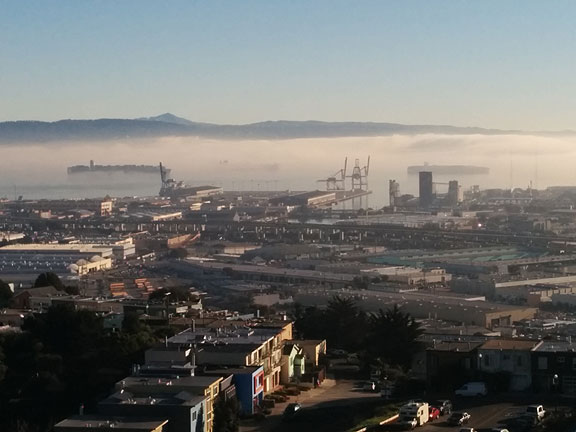 On my first day back from vacation yesterday morning I went up Bernal Heights in bright sun to find that the bay was engulfed in low-lying fog. So beautiful! Here are some ships at anchor, emerging ghostly from the fog with Mt. Diablo in the far distance behind the Oakland hills. Gentrification and Liberalism, San Francisco and Beyond
Thanks for inviting me to participate. I’m a local historian and a long-time writer about the stupidity of modern work and the field of economics, so for starters let’s just say that gentrification cannot be addressed in isolation from social amnesia or work. I think gentrification is a concept that hides as much as it purports to reveal. The word sometimes functions as a marker even while it can allow us to leave out history or broader questions of how we organize the production and reproduction of life in all its complexity.
The physical spot we’re in here at The Battery has gone through some mighty transformations in the relatively recent past. We are here on a spot that used to be part of San Francisco bay. Not so very long ago, less than 200 years, a couple of blocks west of where we are was a beach with a creek burbling in about where the Transmerica Pyramid is now… in 1837 the first house was built by William Richardson at apx. today’s Clay and Grant (up in Chinatown) and years later his son told a story about sitting on the porch gazing down sandy slopes at the mudflats revealed by the low tide. There he saw dozens of huge fish, probably sturgeon and salmon, beached in the mud by the tide, being fought over by a coyote, a wolf, and a grizzly bear.
The old Barbary Coast grew up here along Pacific Avenue, originally on piers and platforms over the open bay. It was home to vice and crime of all sorts, perhaps the most dramatic being “shanghaiing”—the business of providing sailors to ships, by hook or by crook. An 1897 U.S. Supreme Court decision excluded civilian sailors from the 13th amendment’s protection against involuntary servitude, arguing that sailors were deficient in that full and intelligent responsibility for their acts that is accredited to ordinary adults, and therefore must be protected from themselves in the same sense in which minors and wards are entitled to the protection of their parents and guardians!Decades of organizing sailors into unions finally led to the banning of “shanghaiing” in 1906.
Fifty years after that, this area was a teeming center of the produce district. Most people were speaking variations of Italian and the abundant produce of California’s agricultural industries flowed from inland empire to the City’s waterfront finger piers, and from there into the wholesale markets, canneries, and other facilities that made this the heart of Italian North Beach. In the 1950s a double-decker freeway was built along the waterfront ending—temporarily, thought the highway planners—at Broadway, with on and off-ramps just a block from here. The relatively new-at-the-time Redevelopment Agency chose this part of town for its first major project—the removal of the Wholesale Produce Market and the expansion of downtown east and northward. This modernization process also led to the destruction of the old Montgomery Block, home to dozens of San Francisco’s bohemian artists and writers for many decades, and its eventual replacement by the Pyramid.
Concerted efforts by local citizens led to rezoning of the Jackson Square historic district before it was engulfed by new highrises. Another dynamic political movement arose to oppose the crisscrossing of San Francisco by elevated freeways, ultimately stopping over a dozen plans and eventually, with a helpful earthquake in 1989, leading to the removal of the Embarcadero Freeway and the flourishing of a tourism-based economy along the waterfront. That could only make sense because another huge social movement had finally changed our relationship to the San Francisco Bay. For a century it was a given that filling the bay was a good thing and finally in the early 1960s people organized to stop it. They largely succeeded with the creation of the Bay Conservation and Development Commission and subsequent environmental regulationssuch as the Clean Water Act. Today, saving the bay, along with the freeway revolt, are foundations for the environmental and urbanist movements that are still battling to make this a good place to live.
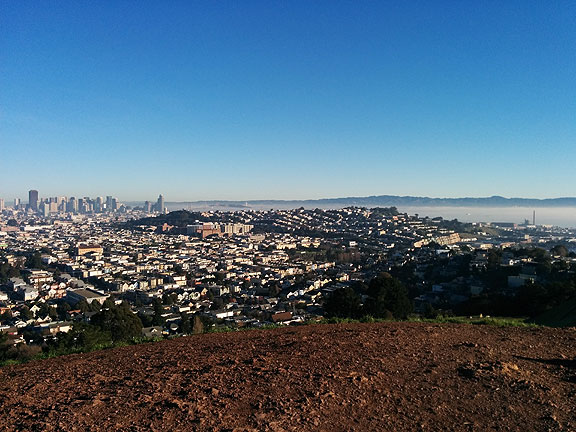 Crispy morning in January, view from Bernal Heights. I arrived in San Francisco in 1978 at the age of 20 and moved into an apartment on Cole near Haight when Haight Street was 50% boarded up. At the time it was slummy, trashed, full of alcoholics and drug addicts, depending on its exaggerated reputation derived from the hippie era. Within a couple of years, it was gentrifying, and by the time I moved to the Mission in 1987 people had been complaining for years about how the Haight was being taken over by yuppies.
Gentrification has been going on for several decades at least, but we tend to notice it episodically when the effects are most extreme, when neighborhoods and communities are at their most threatened. The word itself probably obscures as much as it reveals at this point.
What we’re experiencing these days is called in many parts of the world “neoliberalism.” Neo of course means new, so what is this new liberalism and how is it different from the Old Liberalism that preceded it? I think this distinction is an important one for understanding what is different about how gentrification is affecting us now, compared to how it was when I saw it beginning in the late 1970s in the Haight.
Precisely at that time, during the presidency of Jimmy Carter, and in the wake of Nixon’s southern strategy that coaxed millions of white racists into the Republican party, the Old Liberal coalition that had come together under Franklin Roosevelt in the New Deal was falling apart. Old liberalism had strong proponents in San Francisco, mostly Irish Catholics from the Mission District who dominated City and state politics during the middle of the 20th century. Old liberalism had a purpose, forged in the Depression of the 1930s. It was strongly opposed to laissez-faire economics, and understood that Capital could not be given a free hand without serious damage to the fabric of life. Regulation and government economic intervention were necessary to achieve fairness and prosperity for the majority of the population. These liberals were also believers in the American way of life, including private property and the importance of so-called free enterprise. They saw themselves as the only hope to save capitalism when it was threatened by the godless communists, who were not only atheistic but totalitarian. During WWII liberals and communists worked together to defeat fascism and for a brief moment at the end of the war it seemed that a kind of Scandinavian social democracy might emerge in the U.S. too, with guarantees to housing, health care, decent jobs, public education, social security, and more.
But the Cold War and the possibility of nuclear war overshadowed everything. The largest strike wave in U.S. history in 1946 led to the passing of the Taft-Hartley Act in 1947 by a Republican congress determined to curb the power of the working class to win strikes and expand its power. Moreover, though they joined the consensus on the liberal expansion of the state, the conservative politicians of that time made sure the vast majority of that expansion would be oriented towards empire and the military. In fact, the interstate highway program was sold by Republican President Eisenhower, the former WWII general, in part for its importance to military defense. Old liberals closed ranks with conservatives against the communists during the Cold War, often becoming aggressive hawks to prove their patriotism. During this era, there were liberals and conservatives in both Democratic and Republican parties, a reality that didn’t really begin to change until the breakdown of Old Liberalism in the 1970s. Continue reading Gentrification and Liberalism, San Francisco and Beyond
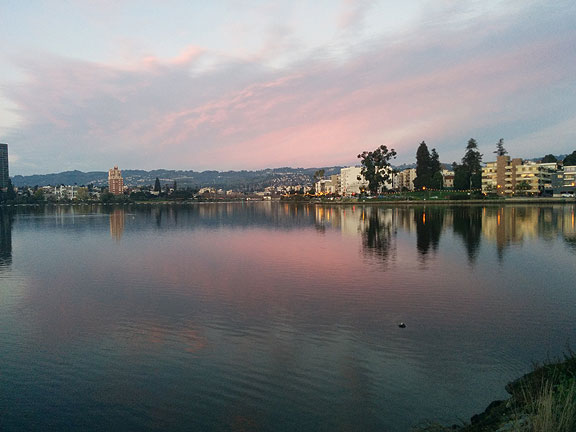 Walking around Lake Merritt on December 7, the light was just gorgeous… epicenter of gentrification and protest during these years, and it will continue to be for some time I’m sure. Rage and patience, despair and exaggerated confidence—emotions that have been swirling around lately. The demonstrations, blockades, and protests of many varieties have come as an inspiration and their resilience and fortitude is absolutely surprising. Something new might be happening, something we’ve dreamed of and hoped for, for a long time. I’ve seen tweets and facebook posts claiming an insurrection is underway but that seems grandly overstated, the hubris of youth at best. On the other hand, the steady unrelenting pressure in the streets in Ferguson, New York, Oakland, San Francisco, Milwaukee, Chicago, Los Angeles and other places, combined with the recognition that the protagonists are not the same old faces (even if some of them—us—are out there too!), is worthy of close attention and critical support. More on this in a minute.
It’s the end of another year. I found myself writing a lot less this past year. No book project underway (though that’s about to change), blogging once a month at best. Instead of thrusting my own views onto the world (something I’ve done plenty of in my life, after all!) I seem to have taken a break. I didn’t decide to do it, but instead of opining on everything going by, or forcing myself to write something that I didn’t feel particularly inspired to do, I spent a lot of time reading other peoples’ words, mostly books, but plenty of magazines and to a lesser extent, online and electronic writings. I do download or bookmark a lot of articles and even whole publications but I rarely go back and read them because frankly, I like physical books and magazines much more than electronic reading. Partly I had to do some catch-up reading to be able to be a good teacher in the classes I taught at the SF Art Institute, and partly I have a tendency to accumulate books I want to read and haven’t made enough time for them. So I was able to plow through dozens of fantastic books this year, all of which have helped deepen my growing historical knowledge about San Francisco and California, as well as filling in important gaps in my grasp of 19th century history.
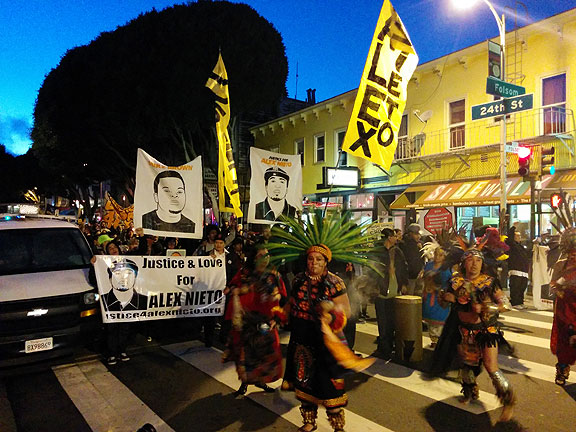 Marchers pause at 24th and Folsom during the longest night of the year, celebrating a Posada for Alex Nieto. Anyway, I have also been in a small, background support role to Adriana’s amazing work on the Alex Nieto case. After his murder by local police on March 21, 2014 she threw herself into working with the family and friends and that has been absorbing much time and attention around our house. She’s determined to shape the narrative, which has put her in the role of the tortoise vis-à-vis the hare known as the San Francisco Police Department. When they shoot someone, their modus operandi (apparently this is the model used across the U.S., probably developed by the FBI with major input from the politicized cops and ex-cops who run police unions) is to assassinate the character of the victim within hours of the shooting. Instant criminalization irrespective of any facts is an essential component of their strategy, and its purpose is to put up a cloud of doubt over the circumstances under which the victim was killed. Then, having “established” by leaking false or irrelevant information that the person shot by police somehow caused it themselves, either because of prior interaction with law enforcement or all too often because of documented mental health issues, the police can claim that they were endangered and had to use deadly force. They did this to Alex Nieto—you can read how they took 18 hours to inform the family they had killed Alex, how they bluffed their way into their home and tried to find “evidence” to use before telling what happened, and so on. It’s amazing that this case doesn’t already have the kind of national profile that Michael Brown and Eric Garner and some others are getting. But it may get there yet, since anyone familiar with the facts can see that Greg Suhr, the San Francisco police chief, is probably personally involved in obstruction of justice and a cover-up, and the whole department is doing whatever it can to delay, obfuscate, and prevent a proper investigation from taking place. Continue reading Rage and Radical Patience
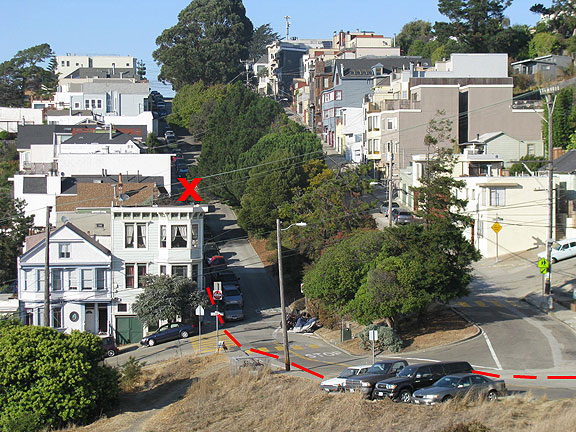 “X” marks the spot where I was held up at gunpoint on Friday, November 14 at 1:45 pm. I was robbed at gunpoint last Friday at 1:45 in the afternoon. A young man appeared out of nowhere on a sunny tree-lined street on Potrero Hill and abruptly pointed a large semi-automatic pistol at my head as he instructed me and the man I was walking with to hand over our cameras, wallets, and phones. We complied. At first it’s difficult to believe that it is real, but after the first shock I quickly adjusted to the probable fact that my life was being threatened if I didn’t hand over my property. As it happens, I was subjected to repeated robberies and some extremely violent attacks as an adolescent in the early 1970s. I learned then that resistance led to worse violence, so my ingrained resignation to the situation served me well last week. After handing over our things following the robber’s methodical instructions, we were instructed to turn around and walk back down the hill, which we did. We were not shot, pistol-whipped, or even physically touched, so you might say we got off easy.
We turned the corner and found an open office a block later and from there called 911. Within minutes squad cars were careening around the nearby streets. The police took our description of the assailant and what he took and in ten minutes there were reports of an arrest in the public housing projects over the hill a few blocks away. Each of us was brought separately to “cold” identity the suspect. Where we had been confronted with a wiry, 20-something 5’10” African-American guy with a thin mustache clad in a gray hoodie, the cops were now holding a guy who was wearing plaid pants, a strange partial black elastic band around his otherwise bare torso, and hatless; he had disheveled hair and very pointy ears! I could not tell if it was the same guy. It might have been. But probably not… I already have a very mistrustful relationship with the police, knowing too much about their lawless handling of young men in the Mission over the past years (and the apparent cold-blooded murder at their hands of Alex Nieto on Bernal Heights last March). The officers I was with were professional and did nothing to offend me, but the whole scene of having other officers holding this guy 80 feet up the hill while I sat in the back of a squad car trying to see if he was the same person who robbed us was disturbing.
Adrenaline kept me going for a few hours as we walked back and my friend got in his car to drive home. I went to my house and began the tedious process of cancelling all my credit and debit cards and getting new ones issued, new cards for insurance, public transit, etc. Two hours later when I had finished my journey through voice-menu hell, I went off to buy a replacement phone. Whenever my mind was not on the immediate tasks at hand, I felt a growing anxiety deep in my chest. “Jangly” was the word one friend used to describe how I would feel for a while when I posted the experience in brief to Facebook. (I was surprised to receive over 100 messages of great compassion and warmth from friends near and far, which was an unexpected silver lining to this experience.) Here’s what I posted:
Well, had to pay the tax today. I was held up at gunpoint by a young man on Carolina Street between 23rd and 22nd, west side of street not far from the stairway connecting the two sides… he got my wallet with cash, credit/debit cards, driver license, an uncashed check, etc… and my camera and my cellphone… lost about $1,000 in total, and of course my insurance has a $1k deductible… so it’s my tax payment to a world of gross inequality I guess… the gentleman I was walking with, helping him with his book project, lost a much nicer camera/lens kit and all his wallet and phone too, so our robber did awfully well at our expense… a crime of opportunity indeed…
Mostly the comments have been expressions of sorrow and solidarity and compassion, but some people talked about how they may have reacted quite differently with combinations of rage and shame, especially after the fact. A couple of folks took issue with my lack of anger towards the assailant, wanting to refocus me and everyone else on the personal guilt of the individual that no “context” can exonerate.
Truth is, given the rapid polarization of wealth we’re living through, it’s more surprising to me how little of this armed expropriation is going on. I don’t forgive this man for pointing a gun at me. It’s unacceptable to threaten someone’s life over anything, let alone a few hundred bucks (that he got higher value was just his good luck and our bad). I’d like to believe that the gun was unloaded and that this was just good theater, but actually it was probably loaded, and this guy might well have shot me in the face if we’d reacted with anything other than the calm compliance we did. It’s deeply unsettling to think my life could have been snuffed out at that moment, and a point of real happiness that I got to have a great time speaking with dozens of friends on Saturday at the first Howard Zinn bookfair, and then spend Sunday with Adriana, going for a hot tub and massage, and generally relaxing, and trying to let go of the looping thoughts that are still jumping around in my head.
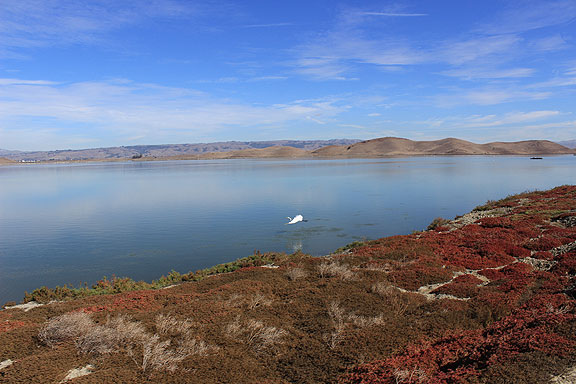 Here’s a great white heron taking flight over a former salt pond near Coyote Hills in the eastern South Bay. The rest of the photos in this post are shots I post to say “farewell” to the camera that was stolen, which had a nice zoom and captured some great shots while I had it…
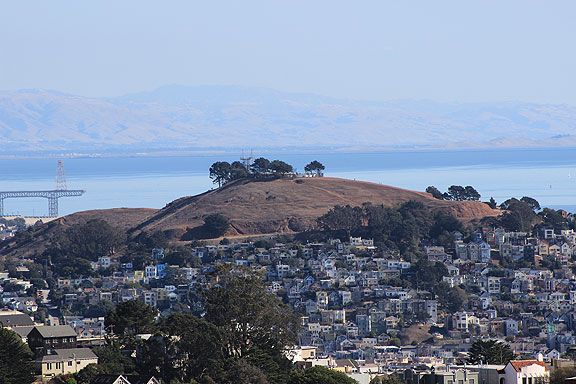 Here’s a foreshortened view of Bernal Heights with Coyote Hills in the back right, 40 miles southeast. Continue reading Life During Wartime
|
Hidden San Francisco 2nd EDITION!

NEW 2nd EDITION NOW AVAILABLE!
Buy one here
(Pluto Press, Spring 2025)
|


















